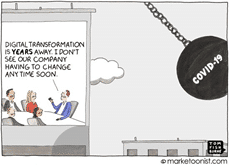A sure sign COVID-19 is forcing business leaders to rethink their digital posture is when it starts showing up in memes. Here are two of my favorites:


The truth is, whether intentional or not, organizations are now more digital than they were a month ago. What does this mean for the future? How can you take advantage of the “kick in the pants” that COVID-19 has delivered and ensure that your company not only survives, but thrives, in this new, more virtual environment?
My colleague Jonathan Murray recently put forward a framework for organizations to use in his posting Now’s the time to check your digital posture. Here’s a brief summary:
- Digital Posture has four facets: Breadth and maturity of digital products and services portfolio, end-to-end data enabled digital processes, completeness of digital tooling and the sophistication of digital culture.
- C-suite executives and corporate board members should prioritize improvement of their organization’s digital posture now to absorb unforeseen market shocks, drive growth and improve competitive advantage.
- Organizations with a mature digital posture are more agile and resilient to external shifts.
- There are straightforward metrics to assess the maturity of your organization’s digital posture.
There are two aspects to digital culture, a set of attributes or focus areas, and a set of operating principles: making business decisions based on data and evidence, pushing decision rights to the edges of the organization and clear strategic direction, guidance and leadership from the top. How these operating principles are applied across the business is the focus of this article. We will focus on how to measure and develop your organization’s digital culture. You can boil it down to five attributes: customer centricity, innovation, collaboration, transparency and decentralization. Here they are in more detail:
Customer Centricity
The bedrock of a strong digital culture is strategic and tactical decision-making based on direct and widely disseminated customer feedback and data to guide these decisions. Here are a few recommendations on how to build and maintain a customer- and data-centric organization.
- Customer definition – Understand who your customers are by creating customer personas and validating their needs based on interviews, their digital behavior and in-market research. Then use these personas to create intentional “digital journeys” that validate your users being able to take actions that meet their needs. Regular customer feedback is a necessary building block for a customer-centric organization.
- Data-driven operations – A customer-centric organization needs to be data-driven to translate customer needs into its operational workflow. What percentage of your operational decisions are augmented with real-time data from operational processes?
- Data governance capabilities – What is the maturity of your organization’s data governance? Who are the stewards of your data and what are your policies in terms of integrity, cleanliness, value, privacy and security? Now is a good time to set up a data governance group that includes product, content, business analysis and technology staff.
- Organizational Assessment – How do your employees assess the organization’s data and customer centricity capabilities and effectiveness? Be sure to include this topic of discovery in your employee engagement survey.
Innovation
COVID-19 has presented organizations with an immediate test of their capacities for agility and innovation. In a matter of days, restaurants had to transform themselves into food prep and contactless delivery services, realtors had to rely on virtual tours to sell houses and industrial titans had to change or build new assembly lines on the fly to produce medical supplies. And virtually every organization had to adapt to most, if not all, of its employees suddenly working from home for the foreseeable future. Companies that have made these pivots successfully are the ones who understand the value of adaptivity, flexibility, creativity and resiliency when dealing with complexity and change. How did your organization do? How can you measure, compare, and grow your capacity for innovation and agility? Here are a few suggestions for focus and measurement:
- Work location flexibility – Evaluate learnings from the current work-from-home (WFH) environment. There is probably a new normal of WFH vs. office that benefits both employees and their employers moving forward. Where does your organization fit in that continuum?
- Research and development budgets – Industries differ greatly in how much R&D is needed to stay innovative. Tracking your organization’s investment appetite and ensuring that you aren’t underfunding R&D efforts is more important than ever.
- Rapid prototyping – Does your organization have an ability to “fast-track” promising ideas and test them in the marketplace quickly and inexpensively?
- Organizational assessment – How do your employees assess the organization’s innovation and agility capabilities? Key questions for an employee engagement survey.
Collaboration
Engaging in cross-functional activities, breaking down silos, and generating collaborative solutions that leverage everyone’s capabilities is even more challenging in today’s WFH environment. How can you ensure your employees and teams are working together and staying engaged when they only “see” each other in Zoom meetings, Slack, Teams or group emails? Here are a few thoughts on how to spur and measure collaboration:
- Organizational network analysis – A number of platforms and services help you measure the connectivity of your staff and teams by analyzing emails, calendar entries, chat messages and other channels. They can provide a “heat map” that identifies collaboration levels among teams, inter-disciplinary groups, etc.
- Team effectiveness – Most organizations evaluate and review individuals but not teams. Evaluating and measuring teams on established goals and metrics can give you necessary insight as to what makes a team high-functioning, or corrosive. Teams can be evaluated on a number of metrics, including project delivery, goal completion, inter-personal relations and team self-assessments.
- Cross-functional task force – An organization can help break down departmental boundaries and silos by intentionally creating cross-functional teams to tackle specific issues or initiatives. This can be particularly useful when aimed at customer issues that span across the organization.
- Organizational assessment – How do your employees assess the organization’s collaboration and interdependence capabilities and effectiveness? Another vital area to explore in an employee engagement survey.
Transparency
A strong digital culture requires regular sharing of meaningful and insightful information and data across multiple stakeholders within the organization and treats communication as a two-way street with honest feedback moving in both directions. Here are a few recommendations on how to foster this type of transparency in your environment:
- Information flow – Understanding the percentage of time CEO and other senior leaders spend communicating (speaking and listening) with staff in real-time can be eye-opening for many organizations. And making it a metric you monitor can influence behaviors and improve morale.
- Tools – There are now a multitude of effective communication tools available in-market. What platforms does your organization make available for communication and transparency? Are you balancing real-time communication with other modes better suited for deeper conversations or across multiple countries and time-zones?
- Organizational assessment – How do your employees assess the open communication and transparency of important information within the company? An engagement survey that makes being transparent a key discovery metric will build trust and a sense of accountability.
Decentralization
How widely and deeply does your organization distribute the authority to make decisions and generate ideas? Here are a few thoughts on how best to create and measure these capabilities.
- Decision-making authority – Clarify who can make decisions in your organization and measure what percentage of operational decisions require face-to-face negotiation and agreement vs. decisions that can be made autonomously within the organization.
- Approval processes – Measure the percentage of operational decisions that require specific approval by a more senior member of staff, and assess whether changes are needed to increase agility.
- Idea generation – Where do new product and market opportunity concepts and ideas come from? If they’re only coming from the executive team and consultants, employees won’t have a chance to contribute their best thinking or feel empowered to help grow the business.
- Organizational assessment – How do your employees assess the empowerment and decentralization capabilities and effectiveness? Employees will be responsive to an engagement study that explores how you might empower people at the “edges” of various departments and divisions.
By implementing, managing and measuring results against these five attributes of digital culture, your organization will be better positioned to capitalize on some of the changes that have been foisted upon all of us in 2020.
Stay in touch for future discussions on digital posture
The principals at Mod Op Strategic Consulting have many decades of combined experience in driving growth through digital strategy. Feel free to contact one of us directly to set up a conversation about how we might help your organization assess and implement the strategies required to build resilience and improve your organization’s capability to adapt and respond to the challenges ahead.
| Adriaan Bouten, CEO, Mod Op Strategic Consulting | [email protected] | |
| Len Gilbert, COO, Mod Op Strategic Consulting | [email protected] | |
| Jonathan Murray, EVP & CTO, Mod Op Strategic Consulting | [email protected] |
















